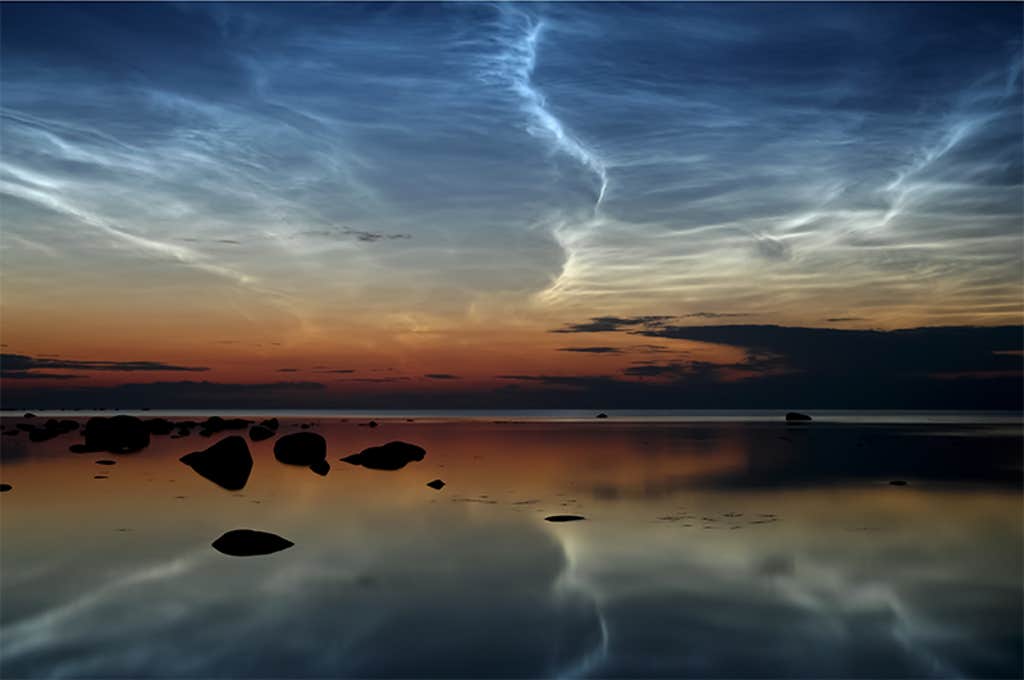They swirl at the very edges of our atmosphere, forming paper-thin ripples that glow electric and pearl blue. They’re lit by a twilight sun catching on ice crystals and seeded by rocket exhaust and space dust.
These are noctilucent, or “night-shining,” clouds—the highest clouds in Earth’s atmosphere—and they seem to be spreading. Some scientists attribute their proliferation to global climate change. If you live in the Northern Hemisphere, you may have a greater than usual chance to spot their ethereal shimmer this summer.
Noctilucent clouds are most visible from the end of May through September in the Northern Hemisphere, but they extend farther south as the season reaches its peak, which happens around July 11. (In the Southern Hemisphere, the season extends from the end of November through February and peaks January 10.)

A century ago, observations of the clouds were only recorded in far northern lands such as Britain, Scandinavia, and Russia. But today, they’re spotted as far south as Colorado or Utah. (They have historically been more common in the Northern Hemisphere than the southern, and geographically, somewhere between 50 and 70 degrees latitude seems to be the sweet spot.)
Noctilucent clouds live about 50 miles above the Earth’s surface, at the outer reaches of a layer of atmosphere called the mesosphere, where meteors typically burn up. The mesosphere lies just above the stratosphere and below the thermosphere, where auroras occur. Paradoxically, the mesosphere is colder in summer than in winter, reaching temperatures as low as -100 degrees Celsius. It is also very dry. The extreme low temperatures allow what water vapor exists to condense on dust and other particles, forming tiny ice crystals that scatter sunlight, giving the clouds their incandescent glow.
Long-term studies based on observations from both space and ground suggest the clouds have become increasingly bright and numerous at polar and subpolar latitudes in recent decades. Some scientists believe the clouds could serve as an indicator of climate change because they are extremely sensitive to changes in ambient temperature and water vapor in the upper atmosphere. While greenhouse gases such as methane may warm temperatures on Earth, in the mesosphere they lower temperatures—and increase water vapor, both of which accelerate the formation of noctilucent clouds.

But other factors also play a role in their abundance, including solar and rocket activity. In 2006, NASA launched a satellite called AIM (Aeronomy of Ice in the Mesosphere Satellite), which helped to reveal that rocket launches stimulate the creation of the clouds when water vapor exhaust from the rockets gets trapped in the mesosphere.
Unlike many astronomical phenomena, no expensive equipment is needed to see the clouds. They appear brighter than the twilight sky, so binoculars are sufficient to illuminate some of the finer details of their architecture, and they can easily be photographed. To help scientists track them, a number of citizen scientist projects have sprung up. Enthusiasts recommend photographing the clouds with stars visible in the background, and from multiple positions, noting the exact times and locations that the photos were taken.
Noctilucent clouds can only be seen about an hour or two after sunset, or before sunrise—when the upper atmosphere is lit up by the sun’s rays, but the rest of the sky is dark enough to let their faint glimmers shine through. The clouds can typically be found streaking the sky close to the horizon, though as the night progresses and the shadow line shifts, they can be found higher up. When the evening deepens and the atmosphere is totally enveloped in the Earth’s shadow, the clouds blink out, disappearing into the night.

The first recorded sightings of noctilucent clouds occurred in 1885, a couple of years after the eruption of the Krakatoa Volcano in Indonesia, one of the deadliest and most destructive volcanic events in recorded history. Two Russian astronomers, V.K. Tseraskii and A.A. Belopolskii, took the first photographs of the clouds and were able to infer their altitude in the range of 45 to 52 miles above the Earth. Observers initially thought they were caused by the Krakatoa eruption, but research conducted since then about whether ash and water vapor expelled by volcanoes can trigger the creation of noctilucent clouds has been inconclusive.
Still, some scientists speculate that this year, the frequency and brightness of the unusual nebulas could get a boost from recent underwater volcanic activity, as well as rocket launches. A 2022 underwater volcanic eruption in Tonga caused huge steam plumes to rise into the atmosphere as the magma interacted with the seawater. This excess water vapor is still accumulating at record levels in the mesosphere where noctilucent clouds form. Exhaust from rockets, which have been launching in growing numbers lately, can also seed the clouds, as the AIM satellite research showed.
Noctilucent clouds can take many shapes—undulating billows, long diffuse streaks, intersecting knots and whirls, vast nets across the sky. The light is electric but the palette is cool, as though the sun were playing a final lullaby to a long summer’s day. With potentially ideal viewing conditions this summer, it’s a great time to keep an eye on the twilight sky. ![]()
Lead photo by Matthias Süßen / Wikimedia Commons
































